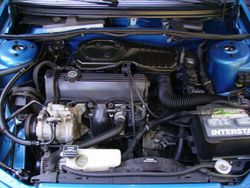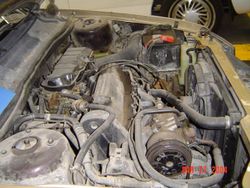Chrysler K engine
The straight-4 engine developed by Chrysler for the Chrysler K and L platforms is sometimes referred to[who?] as the K-car engine. After its debut in 1981, it became the basis for all Chrysler-developed 4-cylinder engines until the Chrysler Neon engine was released in 1995.
2.2
The first K-car engine was normally-aspirated 2.2 L. It was introduced in the 1981 Dodge Aries, Plymouth Horizon and Plymouth Reliant, and was produced until 1994. The 2.2 was a homegrown replacement for the 1.7 L Volkswagen engine Chrysler had initially used in its Omni and Horizon models. Many of the features of the 2.2 are based on the company's experience with the Volkswagen engine, including the aluminum head/iron block design, the SOHC design with in-line valves, the offset water pump, and the location of both the intake and exhaust manifolds on the rear of the engine.
The 2.2 has an undersquare 87.5 mm (3.44 in) bore and 92 mm (3.62 in) stroke, which gives it a displacement of 2205 cc (134.5 cu in). It is a siamesed engine: there are no coolant passages between cylinders. The bore spacing is 87.5 mm (3.44 in), limiting the potential for increased bore diameter. All 2.2 engines have cast iron blocks, use a timing belt and are non-interference engines. The earliest version used a two-barrel carburetor, but fuel injection was introduced in 1984 on turbocharged models and 1985 on normally-aspirated models.
The initial carbureted 2.2 produced 84 horsepower (63 kW), but the output was increased to 96 horsepower (72 kW) and 119 lb·ft (161 N·m). Later versions were fuel-injected and produced 99 horsepower (74 kW) and 121 lb·ft (164 N·m), and a High-Output version for the Dodge Charger produced 110 horsepower (82 kW) and 129 lb·ft (175 N·m). Some were even turbocharged and are referred to as the Turbo I, Turbo II, Turbo III, and Turbo IV. The plain fuel injected 2.2 L competed with Ford's HSC 2.3 L engine in the Tempo and Topaz, using very similar bore and stroke. Ford's HSO engine competed with the 2.2 Turbo versions.
The 2.2 was made at Chrysler's Trenton Engine plant in Trenton, Michigan. In 1988, Chrysler sold much of the machining equipment, as well as a license to the design, to First Auto Works of China. The Trenton plant largely switched to the new Chrysler 3.3 engine production, while FAW continues to build the 2.2.
High-Output 2.2
The 1983 and 1984 Dodge Shelby Charger was more of a handling package, but the regular 2.2 L engine was modified somewhat. This High-Output 2.2 used a revised camshaft to boost output to 110 horsepower (82 kW) and 129 lb·ft (175 N·m), and the block was decked to increase the compression ratio. These modifications allowed the Shelby Charger to hit 50 miles per hour (80.5 km/h) in 5.5 seconds and cover the quarter mile (402 m) in under 16 seconds. The 1985 Dodge Charger Shelby used the 2.2 Turbo I engine instead, so this high output 2.2 was made an option on regular Dodge Chargers that year.
Applications of the High Output 2.2 included the 1983–1984 Dodge Shelby Charger and the 1985–1987 Dodge Charger
2.2 Turbo I
Chrysler's first turbocharged engine was the 1984 Turbo I. It used a Garrett T03 turbocharger with a mechanical wastegate to limit boost to 7 pounds per square inch (48 kPa). For 1985, a computer-controlled wastegate was substituted which allowed 9 pounds per square inch (62 kPa) of temporary overboost. Output was rated at 146 horsepower (109 kW) and 168 lb·ft (228 N·m). A Mitsubishi TE04H turbo and new intake manifold were used for 1988.
2.2 Turbo II
The Turbo II name was applied to a turbocharged, intercooled version of the 2.2 engineered with input from Carroll Shelby. This engine was first used in the 1986 Shelby GLH-S and was produced by the factory the following year. Shelby installed it in his updated 1987 GLHS, as well as his Shelby Lancer and Shelby CSX. Chrysler produced a strengthened version of this engine, with a forged crankshaft and connecting rods, and used it in the Shelby Z package of the 1987–1988 Dodge Daytona. Output was 175 horsepower (130 kW) and 175 lb·ft (237 N·m) with 12 pounds per square inch (83 kPa) of boost. — 200 lb·ft (271 N·m) in the actual Chrysler-built cars with the stronger transaxle.
A similar, one-piece version of the special two-piece intake manifold used on the Turbo II, minus the air charge temperature sensor, was added to the Turbo I for 1988. The next year, the new common block was introduced; it was used for all subsequent versions of the 2.2 and 2.5, including the 2.2 L Turbo II, which then continued unchanged through 1990.
2.2 Turbo III
The Turbo III used a Lotus-made, Shelby-designed DOHC 16-valve head. Output was 224 horsepower (167 kW) and 217 lb·ft (294 N·m). This engine was used in 1,399 Dodge Spirit R/T and several hundred Dodge and Chrysler Daytona IROC R/T models in the US, Canada, and Europe, plus models including the Chrysler Spirit R/T and Phantom R/T in Mexico.
Cars using the 2.2T3 engine include:
- 1991-1992 Dodge Spirit R/T (North America)
- 1991-1994 Chrysler Spirit R/T (Mexico)
- 1992-1993 Dodge Daytona IROC R/T (North America, Europe)
- 1992-1994 Chrysler Phantom R/T (Mexico)
2.2 Turbo IV
The Turbo IV was a turbocharged SOHC intercooled version with variable nozzle turbo (VNT) technology. This allowed the turbo to spool up rapidly for minimal lag, like a small conventional turbocharger, but still produce strong high-RPM power, like a large conventional turbocharger. Dodge and Carrol Shelby pioneered the use of this technology on the 1989 Shelby CSX. Production on this engine was limited to around 1250 units.[citation needed].
2.2 TC
The Chrysler TC, developed with Maserati, used a special turbocharged 2.2 engine. This version was related to the Turbo II but used a special 16-valve head — not the same as that used in the Turbo III — pistons, connecting rods, intake manifold, crankshaft and other components. No parts are interchangeable with other versions of the engine.
The 2.2 TC engine was an international effort: The cylinder head was cast in England by Cosworth and finished in Italy by Maserati. The pistons came from Mahle in Germany, and a Japanese turbocharger was sourced from IHI. The camshafts were designed by Florida-based Crane but were constructed by Maserati in Modena[citation needed]. Most of the rest of the engine was made in the United States and was similar to the Turbo II. Only 500 Chrysler TCs were produced with the DOHC 16-valve head.
2.5
Chrysler upsized the K-car engine in 1986, increasing the displacement to 2.5 L and adding counterrotating balance shafts to smooth out the vibrations and harsh harmonics normally produced by long-stroke 4-cylinder engines. The increased displacement came from a raised deck and longer 104 millimetres (4.09 in) stroke, making the 2.5 engine undersquare and tuned for low-end torque rather than high-RPM power. This engine replaced the 2.6 L Mitsubishi G54B engine that Chrysler had been using. In normally-aspirated form, the 2.5 produced 100 horsepower (75 kW) and 136 lb·ft (184 N·m). In 1989 there was a redesign of the 2.5 to permit both it and the 2.2 to use a common cylinder block; this commonized block, the crankshaft, rods and pistons are completely different from the previous 2.5. Again it competed with Ford Motor Company's HSC engine, which was upgraded from 2.3 L to 2.5 L for use in the 1986 to 1991 Taurus. The Chrysler 2.5 was retired in 1995.
2.5 Turbo
The 2.5 engine was offered in a Turbo I form starting in 1989. This engine had multipoint fuel injection and was rated at 150 hp (111.9 kW) and 170 lb·ft (230 N·m). In some models the 2.5 Turbo I was available in a "High Torque" version, which put out 152 hp (113 kW) and 210 lb·ft (285 N·m) by allowing higher boost pressures at low rpms. In the Mexican market, a 2.5 Turbo II engine with intercooler and intake charge temperature sensing was available, rated at 168 hp (125 kW) and 175 lb·ft (237 N·m) to 188 lb·ft (255 N·m).
2.5 Carbureted
In the Mexican market, 1986 through 1990 vehicles used versions of the 2.2 and 2.5 engines operating on leaded gasoline, equipped with a carburetor, a tubular exhaust header, and electronic control of ignition timing. This induction and ignition system used technology and components very similar to those employed in Chrysler's US-market Lean Burn emission control systems of the late 1970s. This configuration was discontinued in favour of electronic fuel injection for the 1991 model year, when exhaust emission regulations took force in Mexico.
2.2 and 2.5 MPFI
From 1991 to 1995 in the Mexican market, multipoint fuel injected, nonturbo version of the 2.2 and 2.5 were installed in many Chrysler Corporation vehicles. This version of the 2.5 was rated at 113 horsepower (84 kW), and in most cases lacked the balance shafts used in all other versions of the 2.5. The MPFI system gave better driveability, performance and fuel economy, and cleaner emissions, but was nevertheless not used elsewhere than the Mexican domestic market and Chrysler de Mexico's export markets.
2.5 FFV
From 1993 to 1995, a 107 horsepower (80 kW) multipoint fuel injected non-turbo version of the 2.5 engine was installed in flexible-fuel Dodge Spirits and Plymouth Acclaims. This engine and its fuel supply and computerized management system were specially modified to run on fuel containing up to 85% methanol. Most of the MPFI system was common with the Mexican-market 2.5 MPFI engine. Modifications included upgraded seal and gasket materials, chrome piston rings, stainless-steel fuel system components, anticorrosion fuel injectors internally plated with nickel, and fuel composition sensors.
Engine computers
- 1984-1987 : The ECU was divided into the Logic Module (LM), which was inside the passenger cabin, and the Power Module located near the battery on the left front fender. The LM used a Motorola 6803U4 processor operating at 1MHz, with 256 bytes of RAM and either two 8K EPROMs or one 16K EPROM.
- 1988-1989 : The SMEC (Single Module Engine Controller) was introduced. This was a complete redesign of the older system, using modern CAD for board design, and higher density SMD components. The processor was a 68HC11 operating at 2MHz with 256 bytes of RAM and a 32K EPROM. Functionally, the SMEC was the combination of the earlier Logic and Power modules into one unit.
- 1990-end : The SBEC (Single Board Engine Controller) was a new unit, which integrated the earlier two board computer into a single board.
See also
References
- Articles with specifically-marked weasel-worded phrases
- All articles with unsourced statements
- Articles with unsourced statements since January 2008
- Articles with invalid date parameter in template
- Chrysler engines


